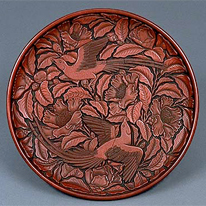Past Exhibitions
- Lacquers from China and Ryūkyū
- June 2, 2015 - July 20, 2015
An enormous amount of Chinese lacquerwork has made its way to Japan. With the adoption of the culture of Zen during the Kamakura period (1185–1333), these items were treasured as karamono ("objects from China") and displayed in major temples and in the homes of daimyo, as well as being coveted by practitioners of the Way of Tea. Plain lacquers from the Song dynasty (960–1279) feature appealingly taut forms, reminiscent of metalwork or porcelain. Meanwhile, carved lacquers, which were popular during the Yuan (1271–1368) and Ming (1368–1641) dynasties, were coated with layer upon layer of lacquer and then carved with a sharp blade into bold patterns. Other decorative methods included mother-of-pearl inlay, incised lacquer with gold inlay, various colored lacquer techniques, and gold foil appliqué. Lacquerwork from the Ryūkyū Kingdom (present-day Okinawa), while heavily influenced by China, included Japanese-style items as well. These beautiful pieces vividly illustrate Japan's fascination with and regard for foreign cultures.












